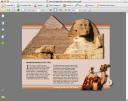Using InDesign and Acrobat for Slide Presentations
I just added a new post to my Acrobat User blog at: Acrobatusers.com for using Adobe InDesign and Acrobat to create slide presentations. Click the link to view this article.
—ted
Adding Buttons to Layers in Acrobat
I just finished a blog post on my other blog site for describing how you can add button fields to Acrobat layers that only appear on the visible layer. If you create a field on a layered PDF document in Acrobat, the field is visible on all Acrobat layers. To learn how to create button fields that can be shown and hidden using Acrobat’s Layers panel, check out my blog post at my Acrobat User Web site.
—ted
Breaking Borders in PDF Files
In a recent article on Acrobat Users, Dallas based graphic designer Bryan Tamayo demonstrated a tip for using Adobe InDesign and exporting to PDF with graphics extending beyond page borders. Bryan offers a PDF file detailing all the steps you need to create images such as the one shown in Figure 1 below. Take a look at his article Thinking Outside the Page.
Figure 1
This article adds a little more to Bryan’s ingenious discovery. To recap the process, you need to place images in Adobe InDesign on Master Pages. Placing the images on document pages doesn’t always work for you in InDesign CS2 or CS3.
Once you place images on a Master Page or different Master Pages, convert the image(s) to a button(s). In InDesign, open the Object menu and choose Interactive > Convert to Button. Once the image is converted to a button, use the Selection Tool (press V on your keyboard) and double click the button.
The Button Options dialog box opens. Click the Behaviors tab and select a button action from the Behavior drop down menu. You might want to use a zoom view or use the Go to Next Page action so when users view your PDF and click the button they advance to the next page.
After selecting the Behavior, click the Add button to add the action in the Button Options dialog. Click OK and the action is assigned to the button. Export the file to PDF and you get a page similar to what you see in Figure 1.
Remember: you need to have the centerpoint for your graphic inside the page edge in order for the graphic to appear in the PDF document.
All of these steps are Bryan’s work and he explains the same steps thus far in his article. What I’d like to expand on is just a bit more about creating buttons in InDesign. Bryan mentions in his article that you need to add all the images on Master Pages. Adding an image to break a border on a document page doesn’t work. In most cases, that’s true. However, there are some exceptions. Take a look at Figure 1 again. You see the drop shadow on the camel and the circle with the page number breaking the right border. These items are placed in InDesign on a document page.
It appears as though when you add a drop shadow to an image and place the image on a document page with the shadow extending beyond the page, then convert to the image to a button, the shadow only extends beyond the page. In addition, notice the circle with the page number. Both the vector art circle and the number were added to a document page. You can add elements on document pages, also convert them to buttons and the items also break borders the same as those elements on the Master Pages.
I’ve found that playing with graphics in InDesign CS3 on document pages does work in some instances. Although I haven’t found the exact steps that make it work all the time, I have found that vector art images usually work as you see in Figure 1. Of course, you need to remember to keep the centerpoint within the document page like you do with the other graphics you place on Master Pages where you want the same effect.
What about layers? Ahhhh… there are some very interesting things you can do with buttons in InDesign and exports to PDFs using layered files. But that’s the subject of my next article.
Download the PDF Document (2.5MB).
breakingborders_numout_layers.pdf
—ted
-
Recent
-
Links
-
Archives
- August 2007 (3)
-
Categories
-
RSS
Entries RSS
Comments RSS
